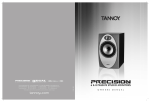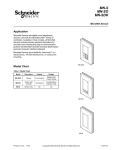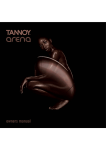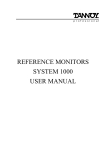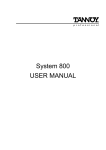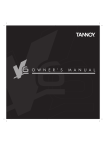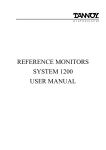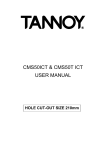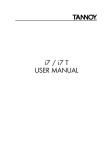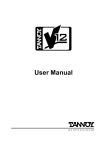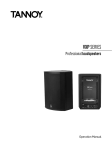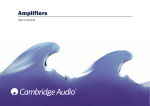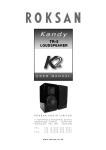Download Ellipse 10 Passive User Manual
Transcript
pa s s i v e owner’s manual CONTENTS 1 INTRODUCTION 2 THE BASICS 2.1Unpacking and visual checks 2.2Preliminary recommendation 2.3 Connecting your speakers 2.4Observing polarity 2.5 Power Amplifiers 3 INSTALLING & POSITIONING 3.1Surround Monitoring 3.2 Bass Ports 3.3Equalisation 4 EXTERNAL DIMENSIONS 5 PERFORMANCE DATA 6 TECHNICAL SPECIFICATIONS 7 SERVICING 7.1 Cabinet finish 7.2 Driver removal 7.3 Crossover 8 WARRANTY 9 DECLARATION OF CONFORMITY 1 INTRODUCTION Thank you for purchasing Tannoy Ellipse Passive Monitors. Designed and manufactured by Tannoy and incorporating new Dual Concentric™ designs these monitors are suitable for desk-top or 5.1 surround situations at near and mid field monitoring positions. Unlike discrete systems with separate low frequency and high frequency drive units mounted on the front baffle the Dual Concentric™ single point source properties and characteristics eliminate horizontal and vertical dead spots around the crossover region and maintain flat phase and amplitude performance across the audible band. A WideBand™ SuperTweeter™ extends the amplitude response of the loudspeaker to beyond 50kHz which results in an extended time and phase response within the audible band. Both Ellipse 8 Passive and Ellipse 10 Passive share the same acoustic balance and dispersion characteristics, and both types can be used in a single 5.1 surround monitoring situation. For example the Ellipse 10 Passive can be used as a centre channel where more power is delivered and the Ellipse 8 Passive installed as effects/surround channels. During mixing and playback both models provide a very accurate soundstage retaining natural voicing to ensure that aural effects and speech localisation pan from left to right and front to rear seamlessly. The Ellipse 8 Passive and 10 Passive are magnetically shielded, permitting use in close proximity to more traditional CRT TV monitors without causing colour-fringing effects. This manual is intended to provide you with some useful advice on how to install and use the loudspeakers, as well as providing more technical information about system design and detailed specifications. The goal is to help you get the best results possible. 2 THE BASICS The Ellipse 8 Passive and 10 Passive monitors are designed and made by Tannoy, a company with unrivalled experience in studio monitoring. They have an extremely detailed, dynamic sound with a wide, flat frequency response - essential requirements for monitoring with reliable accuracy. The Dual Concentric™ drivers contain both low frequency and high frequency drive unit components aligned along the same axis and positioned to generate an acoustic point source. A titanium dome SuperTweeter™ extends the amplitude response of the acoustic radiation beyond the limit of human hearing to above 50kHz. Extending the amplitude response in this way corrects the time and phase response of the system within the audible band below 20kHz. A rear switch on each monitor sets this feature on or off for comparison between WideBandTM and conventional monitoring. The Dual Concentric™ components and the SuperTweeter™ are seamlessly matched by a precision low-loss crossover network. The drive units are mounted on a baffle of elliptical shape to minimise diffraction and create distinctive styling. 2.1 UNPACKING AND VISUAL CHECKS The Ellipse 8 Passive and Ellipse 10 Passive are individually packed and cushioned for safe transit. To remove the speakers from the carton without damage, open the end flaps fully and bend them right back. Turn the package upside-down on the floor and lift the carton vertically upwards to leave the speaker resting on the packing trays. Inspect each speaker for signs of transit damage. Nothing on or in your speakers should be loose or rattle about. In the unlikely event of damage having occurred, inform the carrier and the supplier immediately.Keep all the packaging as this will show evidence of the damage or excessive handling forces. It is also a good idea to keep the packaging if possible for future transportation. 2.2 PRELIMINARY RECOMMENDATION Initially we would like to give a word of warning on high sound pressure levels which these speakers are capable of generating over sustained periods of time. Levels over 95dB sustained for 8 hours or more per day will eventually cause permanent hearing loss. Because Tannoy monitors have very low levels of time, amplitude and frequency distortion it is not always obvious that the sound level is high while working with them. For continuous exposure we recommend the regular use of a sound level meter capable of integrating the sound level over a period of exposure according to noise control standards. This is an Leq measurement and should be used to check that sound levels are always within safety limits. 2.3 CONNECTING YOUR SPEAKERS The types of cable used to connect the speakers to the power amplifier will marginally affect the sound. The cross-sectional area of the cable should be large enough so as not to affect the damping factor; generally a cable 2 with a cross-sectional area of 2.5 mm , or greater is recommended. The Ellipse 8 Passive and 10 Passive terminal panels offer the option of Bi-Wiring. Bi-Wiring provides the facility for connecting separate feeds from the amplifier to the Low Frequency and High Frequency sections of the crossover network. This method of connection can provide better instrument separation, localisation, and imaging depth compared with conventional wiring for the cost of another set of speaker cables. Bi-Wiring provides for separate feed and return cables for low frequencies and high frequencies, low and high frequencies being differentiated by the crossover point of the loudspeaker system; please refer to the technical specifications. This reduces intermodulation effects at high and low frequencies within the cables. The lower the resistance of the cable between the amplifier and the speakers, the better the damping factor acting on the speaker. This has been covered in every audio magazine that has ever been written about speakers, so we won’t beat it to death here. You don’t need to buy speaker cable that costs as much as your speakers. To get the most benefit, select a finely stranded high purity copper speaker cable and dress the cable ends to prevent “hairs” or stray conductors from shorting across the terminals. If your amplifier terminals will not directly accept your chosen size of cable, you can trim down the cable size at the amplifier end. Ensure that the binding post retaining nuts on both the loudspeakers and the amplifier are screwed down firmly without stripping or over tightening them. Ellipse Passive monitors loudspeakers are shipped ready for standard cable wiring with shorting bars connecting both halves of the crossover together. Keep the shorting bars in place whilst connecting your cable if not using the Bi-Wire facility. To Bi-Wire your loudspeakers remove the shorting bars completely from the terminals of the crossover panel. Prepare 2 sets of cables for each loudspeaker, labeling one for HF (High Frequencies) and the other for LF (Low Frequencies) paying particular attention to the polarity of the conductors within the cable. Keep positive and negative conductors (Red and Black) connected to the respective red and black terminals. Parallel both positive conductors and both negative conductors together for the left hand cables at the left hand amplifier terminals. Repeat for the right hand loudspeaker and conductors at the right hand amplifier terminals. 2.4 OBSERVING POLARITY You already know about connecting the positive terminal on the amplifier to the positive terminal on the speakers, and ensuring that both channels are “in phase” by checking to ensure that there’s more bass with both speakers on and not less bass. Absolute polarity is a bit trickier to confirm but is nevertheless very important. Absolute polarity is the maintenance of a positive pressure wave from the microphone capsule all the way through to the listener. A kick drum, for instance, has the drum skin whacked by the foot pedal, and it pushes the air, which pushes the microphone diaphragm, which generates a signal through the electronics and should eventually come out of the speakers as a positive acoustic pressure wave. This means the speaker cones will move towards you, just like the drum skin. All Tannoy monitors have absolute positive polarity which means that a positive going electrical input pulse to the red terminals will move the cones towards you. However, you can’t trust a conventional recorded source to test this because there is no way to confirm that absolute polarity was maintained throughout the recording chain; it can even change from track to track. This isn’t a trivial thing, especially when you’re using a true stereo microphone setup, or trying to accurately place things in your mix. This is something that should be rigorously checked with every microphone and every signal line in a studio; but the first step would be to use the kick drum test described above with a few microphones. If you don’t believe it can make a difference, set up a little test using a mix you know and flip the polarity of both monitor channels at the same time. The imaging will flip from vague (negative polarity) to strong (positive polarity).Hear-Believe! 2.5 POWER AMPLIFIERS The power amplifier should be reasonably well matched in power to the power rating of the speakers (see specifications). The use of a more powerful amplifier (i.e. in excess of the recommended figure) provides increased headroom, which is useful especially for highly dynamic programme material. Due to the high peak power handling of Tannoy monitors, responsible use of more powerful amplifiers should not represent a danger to the speakers as long as the amplifiers are not overdriven. 3 INSTALLING AND POSITIONING When choosing a suitable location for the monitors, bear in mind that the physical mounting of loudspeakers and their proximity to room boundaries can have a large influence on performance. For best results the monitors should be mounted on a heavy rigid structure, supported on four pads making contact with the base of the loudspeaker. The use of small pads of rubber, Sorbothane, or Blu-Tak is recommended. Ensure that the console position does not obscure the direct sound radiation from the loudspeakers when sitting at the mixing position. The engineer and producer should have a clear, uninterrupted view of the monitor loudspeakers. 3.1 SURROUND MONITORING To ensure a uniform acoustical monitoring environment the room should be symmetrical about the centre or dialogue loudspeaker axis and any acoustic room treatments should be applied symmetrically on either side of the room. Mixed “Live end/Dead end” environments should be avoided. If the effects or surround sound loudspeakers are positioned close to walls then the constitution of the wall surfaces should be identical. When using either Ellipse 8 Passive or 10 Passive as the main effects speaker for the front soundstage, placement is a critical factor for good performance. In all cases the centre channel speaker should be placed as close to the viewing screen as possible. The viewing position when seated determines the ideal mounting height, but in all cases this should be as close as possible to ear height. If this is not possible the monitor should be tilted towards ear height in the mix position. The centre speaker should be positioned along the centre axis of the picture and the left/right monitors just outside the picture. Ideally the three front effects speakers should be placed with the front baffles in line with the screen surface. If an acoustically transparent screen is used, the left/right monitors should be placed just inside the edges of the picture. The surround speakers should be positioned at the same distance from the mix position as the main front speakers. 11 A Subwoofer is recommended, chosen from the Tannoy range to ensure compatibility. The Subwoofer/LFE channel produces low frequencies which are non-directional and therefore the Subwoofer can theoretically be placed anywhere in the room. However, from experience, optimum performance will be gained by placing the subwoofer in the same plane as the main front speakers. The LFE channel is set at a level 10dB higher than the other channels when mixing therefore it is important to apply the same in any playback situation. 3.2 BASS PORTS The Ellipse Passive monitors’ bass ports are located on the front panel. You should keep the back panels at least 300mm (12”) away from the nearest wall surface to avoid an overblown bass sound. If you cannot avoid being close to a wall you may want to consider plugging the port tubes on your Ellipse 8 Passive monitors with the closed cell foam-rubber plugs supplied as an accessory within the pack. They are a friction fit for a full seal. This will overdamp the bass alignment of the monitors making them more suitable for 2Pi environments such as for example against a wall or mounted on a large flat surface. Ellipse 10 Passive monitors should be equalized electronically in these circumstances. 3.3 EQUALISATION Our feeling is that you shouldn’t need to equalise monitors at all in a well designed monitoring environment; apparent 12 variations in the monitor response should be fixed through room design or speaker placement. But we realise that equalisation is sometimes a necessary evil especially in small rooms or where the monitors are close to room 13 boundaries. We recommend a good quality speaker controller with digital filtering. Any frequency shaping should be low Q, smooth and you should make use of shelving responses in the frequency range 200Hz to 800Hz. No two adjacent 1/3 14 octave bands should differ by more than 1dB. If you have a choice of equalisers for monitor applications, less is more. The 15 fewer the number of filters, the better the equaliser will sound. Over equalisation can reduce system headroom, and introduce phase distortion resulting in greater problems than cures. Always check out the result of equalisation by listening to well recorded vocals or male and female speech from a familiar source. 16 17 18 19 20 4 DIMENSIONS Ellipse 8 Passive 372.5 [14.66"] R WIDEBAND TM TECHNOLOGY 210.0 [8.27"] 460.0 [18.11"] 320.0 [12.60"] ELLIPSE 8 PASSIVE ellipse 10 passive 423.0 [16.65"] R WIDEBAND TM TECHNOLOGY 250.0 [9.84"] 540.0 [21.26"] ELLIPSE 10 PASSIVE 350.0 [13.78"] 5 PERFORMANCE DATa Ellipse 8 Passive 1m on-axis frequency response 1m on-axis frequency response Sensitivity Mag. dB SPL Watt 100 90 80 70 60 50 10 100 1000 10000 100000 10000 100000 10000 100000 10000 100000 Frequency(Hz) (Hz) Frequency Impedance vs frequency Impedance vs frequency 50 Impedance (Ohms) 45 40 35 30 25 20 15 10 5 0 10 100 1000 Frequency (Hz) Frequency (Hz) ELLIPSE 10 PASSIVE 1m on-axis frequency response 1m on-axis frequency response Sensitivity Mag. dB SPL Watt 100 90 80 70 60 50 10 100 1000 Frequency (Hz) Frequency (Hz) Impedance vs frequency Impedance vs frequency 40 Impedance (Ohms) 35 30 25 20 15 10 5 0 10 100 1000 Frequency (Hz) Frequency (Hz) 6tECHNICAL SPECIFICATIONS Ellipse 8 Passive Ellipse 10 Passive Frequency Response (-3dB) 1 55Hz - 40kHz 42Hz - 40kHz Frequency Range (-10dB) 1 38Hz - 50kHz 30Hz - 50kHz System Sensitivity (1W @1m) 2 89dB (1W = 2.83V into 8 Ohms) 89dB (1W = 2.83V into 8 Ohms) Dispersion (-6dB) 90 degrees fully axi-symmetrical 90 degrees fully axi-symmetrical Driver Complement 200mm (8”) Tannoy Dual Concentric™ 250mm (10”) Tannoy Dual Concentric™ 25mm (1”) WidebandTM SuperTweeter™ 25mm (1”) WidebandTM SuperTweeter™ CrossoverPassive 1.5kHz and 14kHzPassive 1.4kHz and 14kHz Rated Maximum SPL 2 115dB (peak) 116dB (peak) Power Handling 100W (average) 200W (programme) 125w (average) 250W (programme) Recommended Amplifier Power 200W @ 8 Ohms 250W @ 8 Ohms Nominal Impedance 8 Ohms 8 Ohms Distortion <0.5% <0.5% Construction Cabinet volume / LF alignment 19.5 litre/ reflex ported 32.6 litre/ reflex ported. Integral acoustic resonator. Cabinet construction Laminated birch/MDF baffle, internal bracing, detachable neoprene base. Laminated birch/MDF baffle, internal bracing, detachable neoprene base. Finish Textured black paint. Textured black paint. Connectors 4 x 4mm gold plated binding posts (bi-wirable) 4 x 4mm gold plated binding posts (bi-wirable) ControlSuperTweeter™ on/off switch mounted SuperTweeter™ on/off switch mounted on rear termination panel on rear termination panel Dimensions (H x W x D) 373 x 460 x 350 mm 14.68 x 18.11 x 13.78” 423 x 540 x 380 mm 16.65 x 21.26 x 14.96” Weight 13.5kg (29.7lbs) 17.5kg (38.5lbs) Notes 1. Average over stated bandwidth. Measured at 1 metre on axis. 2. Unweighted pink noise input, measured at 1 metre in an anechoic chamber A full range of measurements, performance data, and Ease™ Data can be downloaded from www.tannoy.com Tannoy operates a policy of continuous research and development. The introduction of new materials or manufacturing methods will always equal or exceed the published specifications, which Tannoy reserves the right to alter without prior notification 7 SERVICING 7.1 CABINET FINISH To remove marks and scuffs use a soft brush, avoiding the moving parts of the Dual Concentric™ and SuperTweeter™ 7.2 DRIVER REMOVAL Lay the cabinet on its back. Remove the front mounted port tubes which are a friction fit in the cabinet. Remove the front trim panel using a suitable plastic tool starting aound the port tube holes. Remove the ten hexagonal screws holding down the Dual Concentric™ driver and set aside. Ease the Dual Concentric™ driver from the front of the cabinet taking care not to damage the front surface. Remove the driver, note the polarity of the internal connections and disconnect the internal wiring from both the LF and HF parts of the Dual Concentric™. Take care not to damage the moving parts of the LF driver. To refit the driver, connect the cables from the crossover to the LF and HF terminals. Fit the driver into the mounting hole, making sure that the internal connecting cables are not trapped or able to touch the LF cone. Fasten the screws finger tight and then progressively tighten them down with the appropriate Allen key. Refit the front trim and port tubes. To remove the Supertweeter™ housing remove the Dual Concentric™ driver as above. Working inside the cabinet remove the fixing nut to release the SuperTweeter™ housing and disconnect the cable. Dismantle the housing to release the SuperTweeter™ capsule which must be replaced completely if faulty. Refit all parts in reverse order ensuring cables are correctly connected and cannot interfere with moving parts. Some or all of the acoustic absorbent may have to be removed for access during the dismantling process. Replace each piece in its original position 7.3 CROSSOVER The crossover is mounted on the rear of the terminal panel. To inspect it, remove the panel by releasing the hexagonal screws. Take care to avoid undue stress on the cables and components. It is most unlikely that any of the crossover components will fail during the life of the loudspeaker system. To remove the crossover completely the cables must be disconnected from the drive units. Please proceed as above to remove the Dual Concentric™ drive unit and SuperTweeter™ Housing. 8 WARRANTY NO MAINTENANCE OF THE ELLIPSE MONITORS IS NECESSARY. All components are guaranteed for a period of five years from the date of manufacture, subject to the absence of, or evidence of, misuse, overload or accidental damage. For further information please contact your dealer or the distributor in your country. If you cannot locate your distributor please contact: Customer Services, Tannoy Ltd., Coatbridge, Strathclyde, ML5 4TF, Scotland Telephone: 01236 420199 (UK) +44 1236 420199 (International) Fax: 01236 428230 (UK) +44 1236 428230 (International) Internet: http://www.tannoy.com DO NOT SHIP ANY PRODUCT TO TANNOY WITHOUT PREVIOUS AUTHORISATION This warranty in no way affects your statutory rights. 9 DECLARATION OF CONFORMITY The following apparatus is manufactured by Tannoy Ltd of Rosehall Industrial Estate, Coatbridge, Scotland, ML5 4TF and conforms to the protection requirements of the European Electromagnetic Compatibility Standards and Directives relevant to Domestic Electrical Equipment. The apparatus is designed and constructed such that electromagnetic disturbances generated do not exceed levels allowing radio and telecommunications equipment and other apparatus to operate as intended, and, the apparatus has an adequate level of intrinsic immunity to electromagnetic disturbance to enable operation as specified and intended. This equipment conforms to the requirements of the EMC Directive 89/336/EEC, amended by 92/31/EEC and 93/68/EEC and the requirements of the Low Voltage Directive 73/23/EEC, amended by 93/68/EEC. Details of the Apparatus: Tannoy Monitor Loudspeaker Model Number: Ellipse 8 Passive Model Number. ELLIPSE 10 Passive Applicable Standards:EN55103-1:1996 Emission EN55103-2:1996 Immunity Electrical Safety EN60065:1993 Signed: Position: Date: For Tannoy Ltd Director of Engineering 15 May 2009 NOTES T: 00 44 (0) 1236 420199 T: 00 49 (180) 1111 881 T: 00 33 (0)1 7036 7473 T: 00 1 (519) 745 1158 E: [email protected] E: [email protected] E: [email protected] E: [email protected] Tannoy adopts a policy of continuous improvement and product specification is subject to change. 6481 0549 Tannoy United Kingdom Tannoy Deutschland Tannoy France TC|Group Americas












